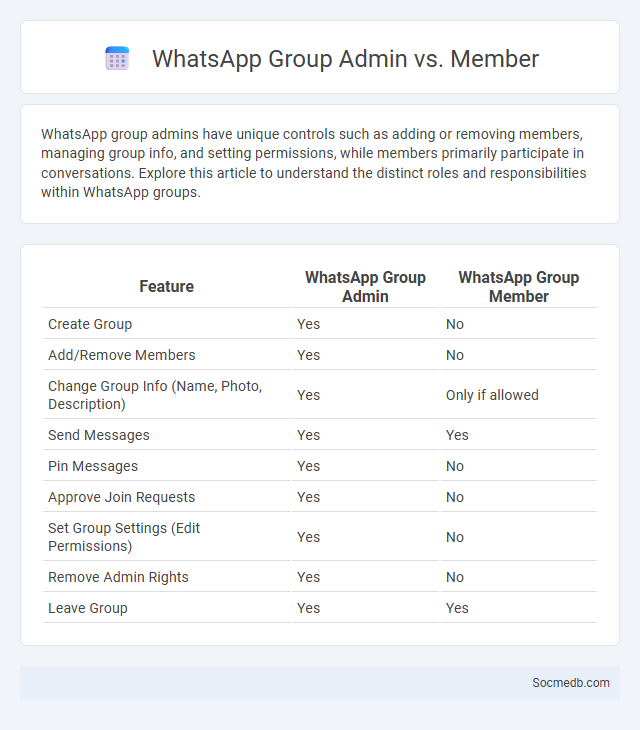
Photo illustration: WhatsApp Group Admin vs Member
WhatsApp group admins have unique controls such as adding or removing members, managing group info, and setting permissions, while members primarily participate in conversations. Explore this article to understand the distinct roles and responsibilities within WhatsApp groups.
Table of Comparison
| Feature | WhatsApp Group Admin | WhatsApp Group Member |
|---|---|---|
| Create Group | Yes | No |
| Add/Remove Members | Yes | No |
| Change Group Info (Name, Photo, Description) | Yes | Only if allowed |
| Send Messages | Yes | Yes |
| Pin Messages | Yes | No |
| Approve Join Requests | Yes | No |
| Set Group Settings (Edit Permissions) | Yes | No |
| Remove Admin Rights | Yes | No |
| Leave Group | Yes | Yes |
Introduction to WhatsApp Group Roles
WhatsApp group roles define the permissions and responsibilities assigned to members, enhancing communication management within digital communities. Admins have control over group settings, member additions, and message moderation, ensuring organized interactions. This hierarchical structure optimizes collaboration and maintains order in large social groups on the WhatsApp platform.
Overview of WhatsApp Group Admin Privileges
WhatsApp group admins hold key privileges including managing group settings, adding or removing participants, and controlling message permissions to maintain group order and security. Admins can designate additional admins to share management responsibilities and ensure efficient moderation. These privileges enable effective coordination and communication within WhatsApp groups of any size.
Key Responsibilities of a Group Admin
Group admins on social media platforms manage member interactions, enforce community guidelines, and maintain a positive environment by moderating content and resolving disputes. Your role includes approving new members, organizing discussions, and ensuring that posts align with the group's purpose to foster engagement and trust. Effective group admin responsibilities also involve monitoring activity to prevent spam and promptly addressing any violations to protect the community's integrity.
Role and Limitations of Group Members
Group members play a crucial role in shaping social media dynamics by contributing diverse perspectives, initiating discussions, and fostering community engagement. Their interactions influence content relevance, trustworthiness, and the overall quality of information shared within online platforms. Limitations arise from varying levels of expertise, potential biases, and the risk of misinformation, which can hinder effective communication and decision-making in group settings.
Comparing Group Admin and Member Abilities
Group admins control member permissions, including posting rights, content moderation, and member management, ensuring a safe and organized community. Members can engage by posting, commenting, and reacting but lack the authority to remove posts or ban users. Your role as an admin enhances your ability to shape group dynamics and maintain a positive environment.
Adding and Removing Participants: Who Can Do What?
In social media platforms, managing participants in group chats or events varies by user roles and platform policies. Group admins or creators typically have the authority to add or remove participants, ensuring community guidelines are maintained. You can usually request permission to add new members, but removing participants is often restricted to maintain group integrity and prevent misuse.
Managing Group Settings: Admin vs Member
Managing group settings on social media platforms involves distinct roles between admins and members, where admins control permissions such as posting rights, membership approvals, and content moderation. You can customize group parameters to enhance security and engagement, ensuring only authorized users can access or contribute to discussions. Clear distinctions in admin versus member privileges streamline group management and maintain a positive community environment.
Handling Group Privacy and Security Controls
Managing social media group privacy and security controls involves configuring settings to restrict membership access and control content visibility. Enabling features like two-factor authentication and moderation tools enhances protection against unauthorized access and harmful interactions. Regularly updating privacy preferences and monitoring group activities ensures safe communication and data security within social networking platforms.
Promoting and Demoting Admins within a WhatsApp Group
Managing WhatsApp groups effectively involves promoting and demoting admins to control group settings and participant interactions. Group owners can grant admin rights to trusted members, enabling them to add or remove participants and change group info, thereby enhancing group management. Removing admin privileges from inactive or disruptive members helps maintain group order and ensures responsible moderation.
Best Practices for Group Management and Collaboration
Effective group management and collaboration on social media platforms require clear communication guidelines, regular engagement, and proactive moderation to maintain a positive and inclusive environment. Your group should have defined roles for admins and moderators to ensure consistent enforcement of rules and prompt resolution of conflicts. Utilizing built-in collaboration tools such as polls, events, and shared documents enhances member participation and strengthens community bonds.
 socmedb.com
socmedb.com